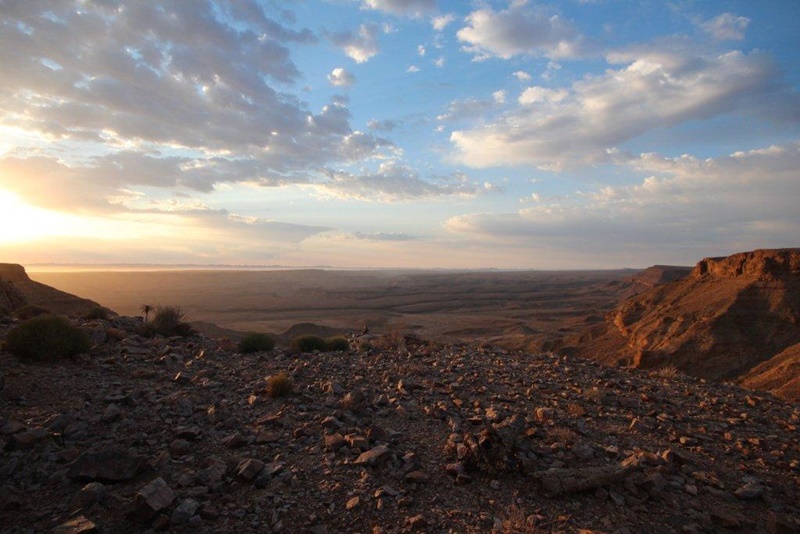We received such a wonderful report from Mary and Andrew from their Namibia self drive adventure! Here is their full report with some very helpful guidelines to self drive through Namibia!
OUR NAMIBIA SELF-DRIVE TRIP
We have just returned from our long anticipated holiday to Namibia. We wanted to see as much of the country as possible and opted to self-drive. Having used Sun Safaris in the past for trips to South Africa, we asked them to help us plan and book this trip. We were put in contact with Jako and so started the experience.
Jako was up-front with us when he said that he was used to helping people with fly-drive holidays but a completely self-drive holiday was a new experience for him. He would need to get a good understanding of what we wanted from the trip and would rely on his ground contacts in Namibia to help him satisfy our aspirations.
We prefer to stay in places where we can meet local people and use their knowledge when finding out what to do and see rather than staying in luxury accommodation. Jako took this on board and we experienced different standards from basic to very luxurious but in every case, it was clean and comfortable. Some places were right off the beaten track which is what we wanted and really appreciated. We met some great people and the Namibians themselves were friendly and welcoming.
Very important was the choice of vehicle. Most of the roads are gravel or sand and it is easy to underestimate the distances involved and the time required to cover them. We drove 4,200km or 2600 miles during the 25 days we were there and for the last 10 days we were joined by our daughter and a friend so we needed something which would be robust and take four people and their luggage in comfort. Jako helped us with this and we hired a Toyota Fortuner which packed a 3 litre engine but was remarkably fuel efficient averaging 9.8km/l. Bearing in mind some of the roads are sand, four-wheel drive would have been preferable but not essential. All that driving and no backache!!
We were met at the airport and after picking up the car were given a pack of information, maps and vouchers for our accommodation and transfers. Our itinerary was a bound document which contained information about what to do at each place as well as details of the accommodation and directions to it.

We started the trip with a stay at Na’ankuse which is 40km from Windhoek International Airport. It was the perfect start being a game farm and animal rescue centre having lion, leopard, cheetah, wild dogs, caracal and baboons. Various excursions are available including one we made to meet San bushmen. It was relaxing and interesting at the same time.

From Na’nkuse we drove some 250km to Intu Afrika Camelthorn Lodge on the edge of the Kalahari. It is characterised by the red sand dunes. Again it is a game farm and the sunset drive was excellent, the sunset itself being spectacular especially with a storm brewing and rain passing in front of the setting sun. Dinner around the fire in the boma added to the atmosphere. This place typifies Namibia being totally different from other places.
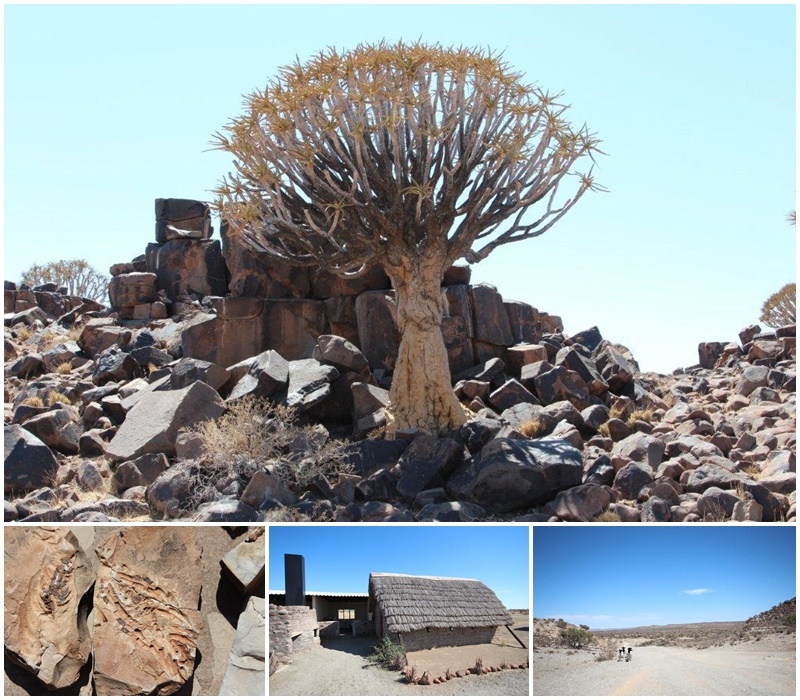
The journey from Camelthorn Lodge to the Mesosaurus fossil site was long but predominantly on tar roads. The site is 50km outside Keetmanshoop and the accommodation consists of four thatched cottages each just big enough to take two beds and a dressing table. They are remarkably cool considering there is no air conditioning. Dinner is a braai cooked by the owner’s son who found the fossils in the first place some 25 years ago. The tour by the owner, Geel, is interesting and amusing and well worth the hour it takes. From here you can visit the Quiver Tree forest and Giant’s Playground. It is right in the middle of nowhere and very quiet. We slept like logs!!

From here we went off the recommended route on our way down to the Orange River at Norotshama near Aussenkehr. We went down the east side of the Fish River Canyon via the Canon Park and Ai-Ais. After turning on to the D545 from the B4, the drive takes you through an oasis in the barren landscape being vineyards and fruit farms, a real surprise. Ai-Ais means “burning water” the hot springs being 65°C and offer no respite from the 47°C temperature outside. Knowing what we now know, we would recommend a stay here or the Canon Park rather than on the Orange River unless you particularly want to do some kayaking or fishing. Norotshama was our least favourite place.
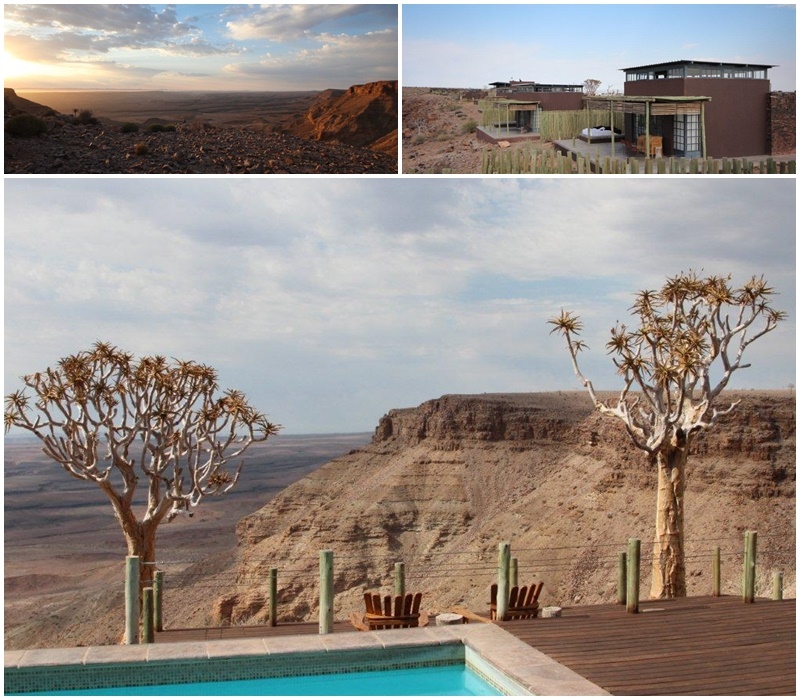
The route from Norotshama to the Fish River Lodge starts with a scenic drive through the pass alongside the river in the Richtersveld National Park. After that, it is 120km of dirt road once you leave the tar 40km north of Rosh Pinar. The Lodge was one of the most luxurious places we stayed but it well worth a visit being perched on the edge of the canyon. If the mood takes you, you can sleep under the stars. We only stayed one night but would have stayed two if we’d had the time. It is truly spectacular.
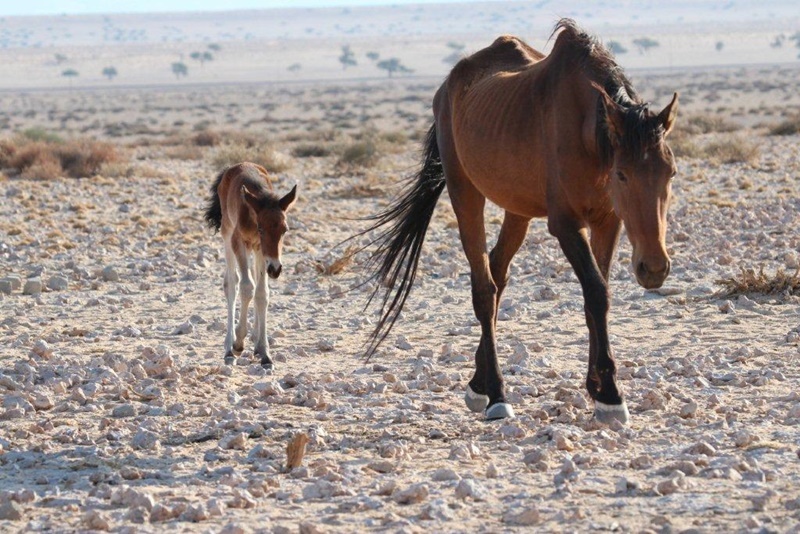
Our next stop was the Desert Horse Inn at Aus aptly named as it is on the edge of the desert between Aus and Luderitz which is home to feral horses. It is the perfect base to visit to the pretty fishing port of Luderitz and the ghost town of Kolmanskop 10km outside Luderitz where diamonds were first discovered at the beginning of the last century. The railway line between Keetmanshoop and Luderitz is being rebuilt but as fast as it is cleared, the wind blows the sand back across it!!


From Aus we returned to the back of beyond with a visit to the Namtib Biosphere, an ecological project miles from anywhere. There is accommodation for 10 people in five basic chalets but the highlight is dinner with Thorens, the owner. Everyone is seated at the same table and the conversation flows irrespective of the nationalities of the diners. An evening drive is an optional excursion or you can take yourself on a walk through the koppies and dry river beds. We got up close and personal to Klipspringer but Thorens didn’t tell us there were leopards in the kopjies until we got back to the farm!! It was another place we would have stayed longer if we’d had the time.
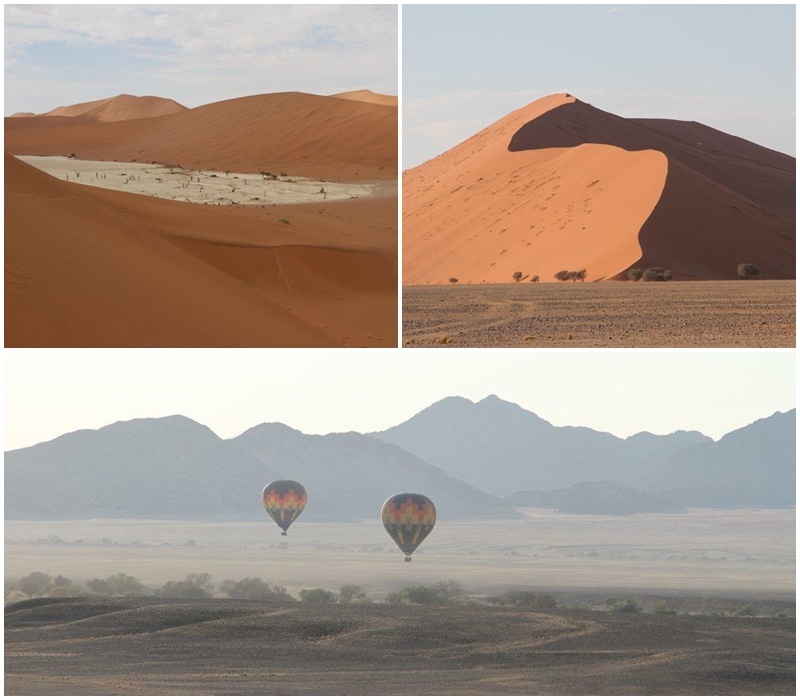
Next was one of the “must see” attractions of Namibia, the dunes at Sossusvlei. If you have a four wheel drive vehicle you can drive yourself to them. The first 60km in the park is on tar but after that it is deep sand. We opted for an organised excursion from our lodge, the Desert Homestead, which was very good and included a champagne breakfast in the bush!! The dunes are spectacular. The earlier you can get there the better as the light from the rising sun is reflected by the sand. Balloon flights are an option but very expensive. If you have the energy you can climb the dunes, the one beside Dead Vlei offering great views over the vlei. It is amazing that the dunes never move despite the strong winds that frequently blow.
Between Sossusvlei and Swakopmund we stopped off at Rostock Ritz near the Gaub Pass. It is in another remote location and again is very nice but in hindsight we would have made better use of time if we had driven straight to Swakopmund even though it is about 350km. The extra day would have been useful elsewhere on the trip.

Swakopmund is another “must” on the journey. We stayed at the Namib Guest House which is a ten minute walk from the sea front. It was excellent and the receptionist, Grescencia, was a gold mine of information. In addition she would book excursions, taxis, restaurants etc as necessary. We took the boat trip from Walvis Bay after visiting the flamingo colony there and made friends with the local seals and pelicans which came on board. After meeting the dolphins in open water we returned to the shelter of the bay for oysters and sparkling wine. In Swakopmund we did a trip called the Living Desert. We were taken into the dunes in four-wheel drive vehicles. Once there the ecology of the desert was explained and the guide found various indigenous species including sand snakes, shovel snouted lizards, chameleon, black scorpion and the beautifully coloured nocturnal Palmato gecko as well as various species of beetle and bird. Sometimes, they also find skink and the venomous sidewinder snake. Afterwards, you are taken on a drive over the dunes which is exhilarating. If you want, you can hire quad bikes or go sand boarding down the dunes. Whilst in Swakopmund make a point of visiting The Tug, a seafood restaurant at the jetty but be sure to book before you arrive in the town. It is very popular and booked up weeks in advance. We were lucky and took advantage of a cancellation. It is not cheap but the food and service are superb. Portions are not small so beware!!
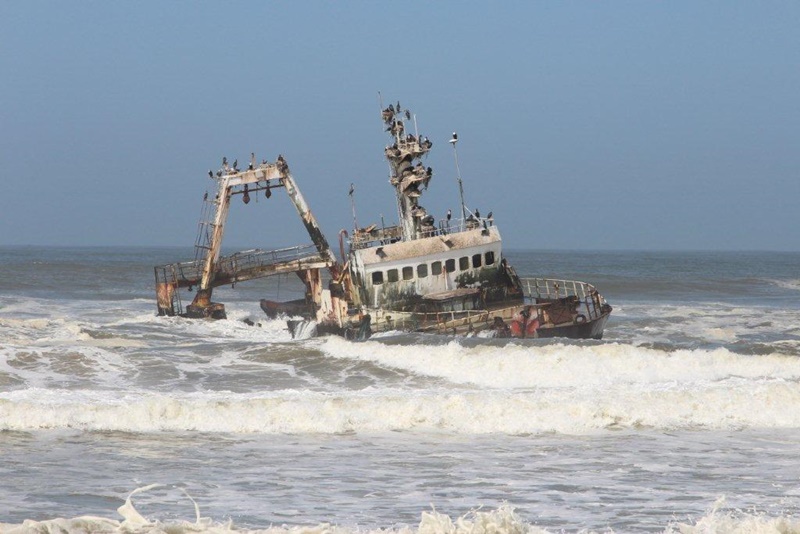
On leaving Swakopmund we drove up the coast for 70km before turning inland. Whilst not strictly the Skeleton Coast, we could see how it would have got its name. It is mile upon mile of windswept beach influenced by the Benguela current. Often there is a mist hence the reason for shipwrecks. Once inland we headed for Damaraland and Mowani Lodge, a luxurious camp built amongst the rocks. Even the swimming pool is hewn out of the rocks. The accommodation and food is first class.


Within striking distance of the Lodge live two herds of desert adapted elephants and some lone bulls. They are able to survive without daily intake of water due to their diet. They can be reached in a four-wheel drive vehicle but the excursion from the Lodge offers a better chance of seeing them and the guide provides a lot of interesting information about them and their surroundings. There is also a pride of desert adapted lions but the chances of seeing them are slim. We also visited the bushman rock art at Twyfelfontein, Burnt Mountain and the organ pipe rock formations.
From Mowani we drove up to the world renowned Etosha National Park but on the way, we took time out to visit the petrified forest near Khorixas. It only takes three quarters of an hour to do the guided tour and is well worth it.
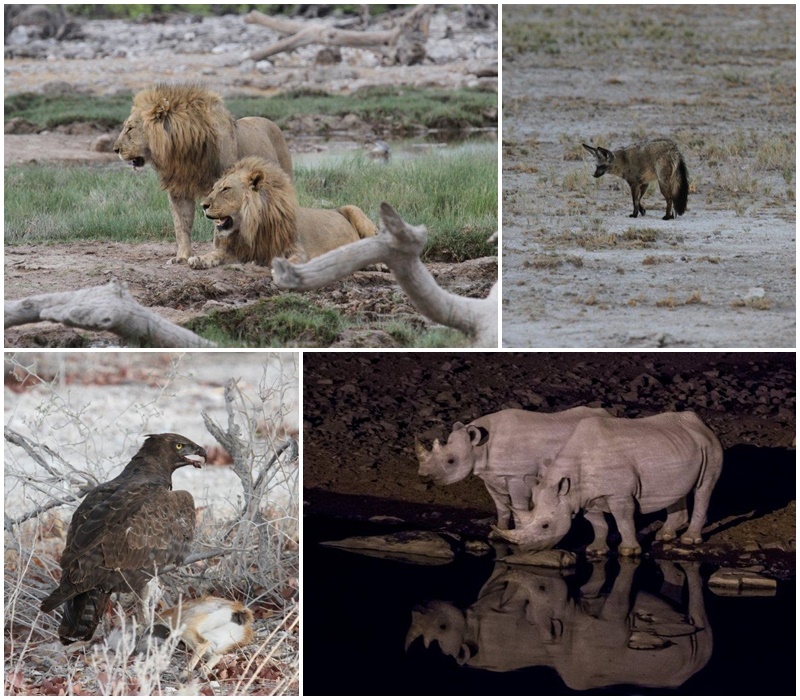
We spent three nights at Halali camp in Etosha. We had a two-bedroomed bush chalet which was basic but meant we could self-cater at dinner because there was a built-in braai. A hearty breakfast was included and was served in the restaurant. If you are self-catering, buy everything before entering the park because there is very little in the camp shops and it is very expensive. There is a water hole at Halali which has an observation area and is lit at night. We were very fortunate to see seven black rhinoceros there one night. On the way to Halali we got the beady eye from a Martial Eagle which had just killed a steenbok and was tucking into its meal. It wasn’t going to move for anyone or anything!! We were also fortunate to see bat-eared foxes which are generally nocturnal. Within the camp was a resident honey badger which raided the dustbins every night. We would have liked more time in Etosha.
Our final stop was the Frans Indongo Lodge near Otjiwarongo, a beautiful lodge some 20km off the main road. It is a lovely place to relax and unwind and was a perfect stopover between Etosha and Windhoek Airport for the flight out. Our only regret is that it was a bit too far from either the Afrikat Foundation or the Cheetah Conservation Project one of which we wanted to visit but did not have enough time.
And so back to Windhoek. After 4200km and some wonderful experiences, the sun finally set on our Namibian adventure. Throughout the journey we never had any concerns about safety except in Windhoek itself. We have listed some of the highlights of our trip below. We are left with memories of a country with a changing landscape. Even though it was very dry when we were there no significant rain having fallen for many months, the landscape changed from desert to mountains to a long flat coastline to dunes to flat farmland to the pans of Etosha. It is a wonderful destination.
We flew from Windhoek to Cape Town and took the opportunity to meet Jako for lunch. It gave us an opportunity to thank him personally and to give him feedback on the trip both positive and negative though all-in-all it was predominantly positive. Many thanks to him for everything he did for us and we hope that our feedback enables him to help plan other such adventures for other clients. For our part, we look forward to future dealings with Sun Safaris and have no hesitation in recommending them to anyone planning a trip in southern Africa. .
Some highlights from the trip were:
- The people
- The red dunes of the Kalahari
- The remoteness of many of the places we stayed
- Fish River Lodge and the canyon
- Namtib Biosphere
- Sossusvlei and Dead Vlei
- Kolmanskop
- The feral horses
- Flamingos, pelicans and seals
- The Living Desert
- The Tug
- Desert adapted elephants
- The wild life, particularly the black rhinos
- Sun rises and sunsets
And some tips if you are self-driving:
- Road numbers on maps are not always the same as those on the road signs!!
- Don’t under-estimate the distances between places or the time it will take to cover them especially on dirt roads
- Drive with dipped headlights on
- Watch out for the “mirage” effect, it will affect your judgement of distance of oncoming vehicles
- Keep your distance. Vehicles in front might well have to stop suddenly for animals or people in the road
- Watch out for said animals and people
- Keep speed down on dirt roads (suggest 80kph) and watch out for hidden dips
- Make sure the vehicle has a cross border permit if it is registered in SA
- Keep fuel topped up at all times
- Not all garages accept cards so always have some cash available
- Take large bin bags and cover your cases. This will help keep sand and dust out.
- Cover cases in back if there is no parcel shelf. A black sheet is ideal.
We hope we have whetted your appetite for self-driving in Namibia.
Mary and Andrew


